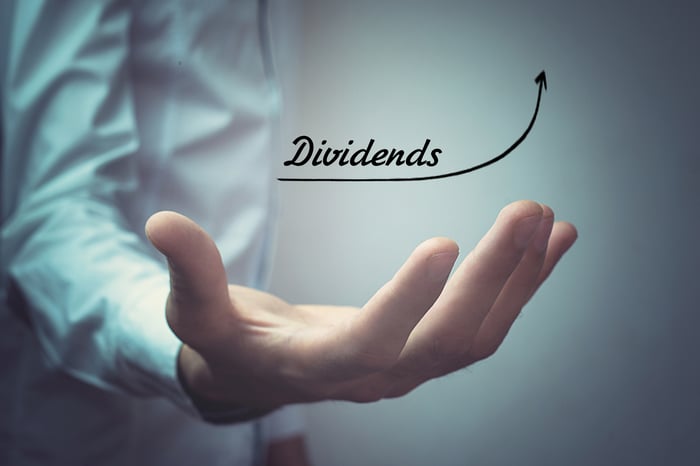Hess (HES 0.37%) doesn't currently appeal to most dividend investors. Not only is its 1.8% yield right around the average of stocks in the S&P 500, but the oil producer hasn't increased its dividend since 2013.
The company's lackluster dividend track record, however, is about to change. That's because Hess is on pace to start generating a gusher of excess cash, which it aims to return to shareholders via share repurchases and a growing dividend.

Image source: Getty Images.
Four engines of cash
Hess has spent the past several years refocusing the company around four main assets, which serve two important roles. Its positions in the deepwater Gulf of Mexico and Malaysia are its cash engines, which give it the funds to invest in its two growth engines: the Bakken and offshore Guyana. Those latter two regions, however, are nearing an inflection point, which CEO John Hess discussed on the company's fourth-quarter conference call. He noted that "both Guyana and the Bakken will become significant cash generators over the next several years." Because of that, the company believes it can deliver about 20% compound annual cash flow growth through 2025. That fast-growing cash flow stream will provide the company with more money than it needs to fund its growth, leaving it with an increasing supply of excess cash.
"As our portfolio generates increasing cash flow," stated Hess, "the majority will be deployed toward increased return of capital to our shareholders through dividend increases and opportunistic share repurchases."
Hess could hit that free cash flow inflection point this year, depending on oil prices. Because 2020 will be another heavy investment year for the company since it's investing a lot of money into both Guyana and the Bakken, it needs the global oil benchmark, Brent, to average around $65 a barrel so that it can produce free cash this year. While crude started the year well above that level, oil prices have plunged because of demand growth fears in China due to the spread of the novel coronavirus.
It will be much for Hess to produce excess cash next year since it expects to flip the switch on the Bakken and turn it into a cash flow machine. In its view, that oil field could produce $1 billion in annual free cash flow post-2020 if the U.S. oil price, WTI, averages $60 a barrel.
Given the upcoming shift in the Bakken, Hess could start increasing its dividend before the end of this year, especially if oil prices begin recovering from their virus-inspired sell-off.
The oil patch is fueling lots of dividend growth these days
When Hess does increase its dividend, it will join a growing list of oil producers that have started sending an increased supply of cash to income investors.
Oil giant ConocoPhillips (COP -0.01%) kicked off the rebirth of dividend growth in the oil patch a few years ago. The company, which slashed its payout in 2016 to better align it with lower oil prices, has since increased it several times. It started small by boosting it by 6% in 2017. ConocoPhillips then raised it twice in 2018 -- 7.5% in February and another 7% in December -- before giving its investors a monster 38% raise last year. More dividend growth is likely over the coming decade given ConocoPhillips' view that it will produce $50 billion in free cash flow during that time frame, which it intends on returning to investors via its dividend and share repurchase program.
EOG Resources (EOG 0.41%) has also become a dividend growth stock in recent years. The company has already boosted its payout 72% over the last two years. EOG, meanwhile, expects more high-octane dividend growth in the coming years as it returns an increasing supply of its fast-growing cash flow to investors.
Several other oil stocks have either initiated dividends or started growing them over the past couple of years as the industry puts a priority on returning cash to investors. This strategy has the potential to give these oil stocks the fuel to outperform the market since dividend growth stocks have historically beat the S&P 500 by a wide margin.
A potentially appealing option for dividend investors
Hess hasn't historically been a good stock for dividend investors, given its lower yield and lack of growth. However, that will soon change since it's on pace to produce a significant amount of cash flow in the coming years. Because of that, it could reward dividend investors with a fast-growing income stream, which is why they'll want to take a closer look at this stock.

